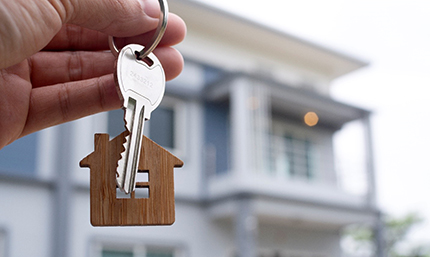[ad_1]
Secluded behind an unassuming brick wall and a Reve d’Or rose-covered gate in the French Quarter, a stone path leads into a secret garden of tropical fronds and gardenias. A pomegranate tree almost conceals the dark green shutters of a petit guesthouse, which peeks through moss-covered branches and hanging fruit.
To the right of the garden sits another building, a jewel box-sized single shotgun with a long side porch. The shotgun is the main house where Bridget and Rick Balentine live. Both the house and guest cottage overlook the courtyard garden containing trellises, statuary and a gurgling fountain.

A faux bricked well and antique sugar kettle form a fountain in the courtyard.
Finding a Creole sanctuary
When the Balentines began their search for a house in New Orleans, they had no idea where they would land. Bridget Balentine grew up in the historic Little Woods community near Hayne Boulevard, Rick Balentine in Chicago. The couple, who married in New Orleans 24 years ago, always kept a foot in the city, flying in from Colorado often to see family and friends.
There, they owned an exclusive decor and marble business, and Rick Balentine still leads the Aspen Fire Department District. Such was his love of his wife’s hometown that he was one of the first volunteer responders to enter the city after Hurricane Katrina.
But after years of visiting, they recently decided on a permanent move. Thus began a hunt to find a property that ticked off everything on their wish list: a separate guest area, walking distance to music and restaurants, an outdoor area for dinner parties and the holy grail for Rick Balentine — a parking space.

Bridget Balentine praises the seamless collaboration between her and architect John Williams.
A long search
After perusing over 30 houses, the couple settled on an intimate compound of three buildings on St. Philip Street: an Eastlake shotgun, a dilapidated Creole cottage and a shed. When they were ready to restore the property, they called close friend and architect John Williams, of Williams Architects.
“We used a holistic approach,” said Williams. “To meet their requirements to move back to the city, they needed off-street parking, a place for friends to stay and a place that would feel like home.”
Working closely with the Vieux Carré Commission, Williams drafted designs to meet modern needs while respecting the neighborhood’s colonial Louisiana aesthetic. The larger building required extensive restoration, the cottage needed a rebuild, and the shed was raised and refitted as a laundry room.

The focal point of bedroom in the main house is a Louisiana landscape mural by local artist William M. Dunn.
The Creole guest house
The cottage on the back of the property line may have been a garçonnière, the apartment of a Creole family’s unmarried males, or could have functioned as servant’s quarters.
“It was a single-level structure from 1845,” said Balentine. “We kept the original fireplaces and were able to put a bedroom and bath upstairs, reusing the old brick.”
Williams says the blueprint stayed within the property’s original footprint. And both he and Rick Balentine speak of preserving the original pitched slate roof, which was reassembled piece-by-piece atop the newly added second floor.
“Everything on the original first floor was kept and reused,” said Williams. “We were able to put the bedroom upstairs using the original materials; old beams from the attic, brick, the balcony, slate and millwork were all repurposed. “

The guest house’s vintage Carrera marble sink originally in the main house.
The reuse of salvaged building materials was integral to the project. Because of this, and despite a total renovation, the property looks and feels old. The French entry doors are the original from the 19th century, but the shutters had to be recrafted.
There’s now a bath on each level of the guest house. On the first, a walk-in shower is made of Venetian plaster. Upstairs, distressed metals, an antique tub and marble-topped console evoke old-world charm.
The masterpieces of the restoration are the curved railings of the outdoor stairs that service the guesthouse. The stairs evoke a historic design by Koch & Wilson located across the street.
“I don’t think there’s anything like the railings in the French Quarter,” said Williams. “The feeling is that it’s floating.”

One of the original 18th Century gas lamps that once lit Canal Street.
The Eastlake shotgun
The four-room single shotgun, built prior to 1895, acts as the main house. The bathroom was enlarged, its low ceiling raised, and the original clawfoot tub reused.
A walk-in closet was configured to add necessary storage to the antique-filled bedroom. The Louisiana landscape mural in the bedroom was commissioned by local artist William M. Dunn to anchor the room.
As with all couples, the Balentines each had a nonnegotiable. Rick Balentine’s must was square recessed lighting.
“I wanted to add a touch of modern,” he said. “We fought pretty hard on that. But I lean toward modern finishes.”
That and the working transom windows were his get.

One of the last 19th century Canal Street gas lamps serves as a hanging pendent over the Artic White kitchen island.
For Bridget Balentine, it was the black Lacanche range and convection oven. A side porch was built to lead into the kitchen for ease of outdoor entertaining.
The kitchen’s design is influenced by a substantial Arctic white marble center island. The dramatic green, black and white stone was the last slab fabricated before they sold their company, said Bridget Balentine. “The marble is named from the scenery viewed when flying over the Arctic,” said Rick Balentine.
The pendant hanging above is one of only a handful of remaining original 18th-century gas lamps that once lit Canal Street. Sourced at The French Antique Shop on Royal Street and refitted for electricity, it remains the standout piece in the house.
Custom cabinetry and millwork were built by James Schiff and interspersed with the house’s original open wood shelving to keep the sense of history. The goal was not to have the rooms look overdone, said Bridge Balentine.
Back home in New Orleans
“I enjoy it here, waking up early, walking to the corner, hearing the music and seeing the carriages running,” said Rick Balentine.
“It’s magical,” Bridget Balentine said of the resulting restoration. “Rick’s so happy now.”
Thirty-one years ago, she said, Rick Balentine fell in love with her and New Orleans. Today, when asked their favorite place in the world, they say it’s the courtyard on St. Philip.
[ad_2]
Source link





More Stories
An Exotic Honeymoon That Never Ends
Averting Building Collapse in Lagos State
Kasumba Square Mall